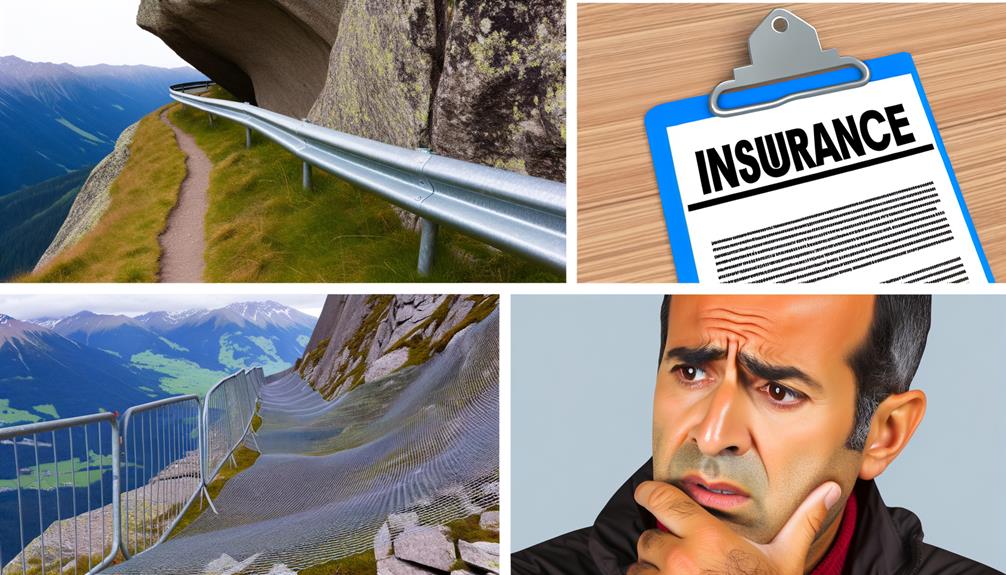Just as a seasoned hiker wouldn't start off on a trek without the right gear, a trail owner shouldn't initiate on this venture without the right insurance coverage. Five essential types of trail guard insurance exist that every owner should integrate into their risk management strategy.
Full liability, umbrella insurance, non-governmental organization liability, risk management plans, and understanding recreational use statutes aren't just buzzwords—they're the foundation of trail ownership protection.
Why are these five types so crucial, you ask? Let's take a closer look and unpack each one.
Key Takeaways
- Property Protection Coverage is essential for repair or replacement costs due to damages to trail structures and equipment.
- Liability Insurance provides financial protection against legal claims and losses from accidents or injuries on the trail.
- Theft and Vandalism Protection offers financial security against stolen equipment or property damage, ensuring service continuity.
- Natural Disaster Preparedness and Equipment Breakdown Insurance are crucial for risk assessment, operational stability, and financial safeguarding.
Understanding Property Damage Coverage

When it comes to safeguarding their investment, trail owners must understand the pivotal role of property damage coverage, which typically provides financial protection against losses incurred due to damage to structures, equipment, or natural features on the trail.
This coverage can be a financial lifesaver, helping to shoulder the cost of repairs or replacements caused by covered perils like vandalism, storms, or accidents. It's essential for trail owners to assess the value of their property and infrastructure to determine the appropriate coverage limits. These limits should reflect the true cost of replacing or repairing damaged property, guaranteeing you're not left out of pocket should the worst happen.
Property damage coverage may also offer protection against liability for damage caused to others' property while using the trail facilities. It's an often overlooked benefit but can prove invaluable in maintaining good relations with trail users and neighboring property owners.
Understanding the specific inclusions and policy exclusions of property damage coverage is key. Not all damage types may be covered, and knowing what's excluded from your policy can help you better manage risk and prepare for potential losses. By comprehending your coverage, you can secure your trails remain a safe and enjoyable haven for all users.
Importance of Liability Insurance

While property damage coverage plays an important role in safeguarding the physical aspects of your trail, it's equally important to contemplate liability insurance, which offers protection against legal claims and financial losses arising from accidents or injuries on your trail. This type of coverage is fundamental to maintaining the financial stability of your trail and ensuring its continued operation.
The benefits of liability insurance are manifold:
- It provides coverage for legal defense costs and settlements if someone files a liability claim after an accident on your trail.
- It covers medical expenses and damages if a visitor is injured on your trail.
- It mitigates the risk of financial losses, protecting your assets and securing your investment.
- It shields you from personal responsibility for legal costs and compensation.
- It gives you peace of mind, knowing that you're prepared for unforeseen incidents that could otherwise lead to financial ruin.
However, be aware of coverage limitations. It's essential to thoroughly understand your policy to make sure it provides adequate protection. Don't skimp on liability insurance – it's an essential safety net that every trail owner needs.
Assessing Theft and Vandalism Protection

In the world of trail ownership, evaluating the need for theft and vandalism protection is a critical step, as this coverage can safeguard you from losses due to stolen equipment, supplies, or property damage. Protecting your trail from such unfortunate incidents is more than just preventing theft or implementing security measures. It's about ensuring the continuity of your service to others.
Reviewing your theft and vandalism protection options, taking into account the location and usage of your trail, is paramount. Different policies offer varying coverage limits and exclusions, requiring careful consideration. This coverage not only provides financial protection but also peace of mind.
| Benefits | Details |
|---|---|
| *Coverage* | Covers losses due to theft of equipment, supplies, or property. |
| *Recovery* | Helps recover costs for replacing stolen items or repairing vandalism damage. |
| *Risk Assessment* | Assesses risk based on trail location and usage. |
| *Peace of Mind* | Provides financial protection and assurance. |
Evaluating Natural Disaster Coverage

Just as important as safeguarding against theft and vandalism is considering the potential impact of natural disasters on your trail, making it necessary to evaluate coverage options tailored to these specific threats.
A thorough risk assessment must be conducted to effectively gauge the potential threats your trail could face due to its geographical location. This process will help you determine the necessary coverage for specific natural disaster threats such as hurricanes, wildfires, floods, and earthquakes.
Beyond the risk assessment, consider the following coverage options:
- Assess property damage coverage, ensuring it adequately covers the costs of repairing or rebuilding after a natural disaster.
- Evaluate business interruption coverage, which compensates for income loss during the recovery process.
- Review liability protection coverage, which protects if your trail causes damage to others during a disaster.
- Consult with an insurance agent specializing in outdoor recreation and trail management to tailor your coverage.
- Regularly revisit and update your natural disaster coverage as environmental conditions and risk factors evolve.
Necessity of Equipment Breakdown Insurance

Understanding the necessity of Equipment Breakdown Insurance is imperative for trail owners, as it provides financial protection against the unexpected malfunction of essential trail guard equipment due to mechanical or electrical issues. This coverage is a safeguard against significant financial losses and operational disruptions that can arise from unforeseen equipment failure.
Even with preventive maintenance, there's always the risk of sudden breakdowns of important security equipment such as surveillance cameras, alarm systems, and gates. Equipment Breakdown Insurance covers the costs of repairing or replacing these important components, ensuring minimal interruption to trail operations.
Importantly, coverage limits should be carefully considered. A policy should be sufficiently robust to address potential losses from business interruptions resulting from equipment failure. Trail owners can achieve peace of mind, knowing that their critical security infrastructure is protected.
Hence, investing in Equipment Breakdown Insurance isn't only a prudent financial decision, but also a commitment to maintaining the safety and smoothly running operations of the trails. It underscores the trail owners' dedication to serving others by ensuring continuous, reliable access to these natural spaces.
Frequently Asked Questions
What Are the Main 5 Categories of Travel Insurance Coverage?
When comparing coverage, they'll find five main categories. These include trip cancellation, emergency medical, baggage loss, travel delay, and accidental death. Each policy offers unique benefits essential for the owner's peace of mind during travel.
What Does Travel Guard Policy Cover?
Travel Guard's policy covers trip cancellations, interruptions, medical emergencies, and baggage issues. However, they've exclusions. It's essential to understand the claim process for efficient service. It's the safety net every traveler needs.
What Does Essential Travel Insurance Cover?
'Essential travel insurance generally covers trip cancellations, medical emergencies, and lost items. However, it's important to understand policy exclusions and the claim process to make sure one's adequately protected during their travels.'
What Insurance Do You Need for a Horse Trailer?
For horse trailer protection, they'll need insurance covering physical damage, theft, and liability. It's important to take into account horse trailer maintenance and comply with trailer safety regulations. Coverage for emergency assistance and vet fees can be beneficial.
Conclusion
Securing the right trail guard insurance coverage is like putting on a suit of armor, providing crucial protection for trail owners. Remember, having thorough liability, risk management plans, an understanding of recreational use statutes, and coverage for public entities and NGOs is essential.
It shields you from unexpected pitfalls like property damage, theft, and natural disasters. So, don't wait, safeguard your trails today, because it's better to be safe than sorry.

